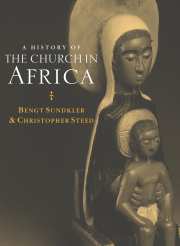Book contents
- Frontmatter
- Contents
- List of maps
- Acknowledgements
- List of abbreviations
- Introduction
- PART I THE FIRST FOURTEEN HUNDRED YEARS
- PART II THE MIDDLE AGES 1415 – 1787
- 2 Maritime Connections
- PART III THE LONG NINETEENTH CENTURY 1787 – 1919
- PART IV THE COLONIAL EXPERIENCE 1920 – 1959
- PART V INDEPENDENT AFRICA 1960 – 92
- Notes
- Bibliography
- Name index
- Subject index
2 - Maritime Connections
from PART II - THE MIDDLE AGES 1415 – 1787
Published online by Cambridge University Press: 16 September 2009
- Frontmatter
- Contents
- List of maps
- Acknowledgements
- List of abbreviations
- Introduction
- PART I THE FIRST FOURTEEN HUNDRED YEARS
- PART II THE MIDDLE AGES 1415 – 1787
- 2 Maritime Connections
- PART III THE LONG NINETEENTH CENTURY 1787 – 1919
- PART IV THE COLONIAL EXPERIENCE 1920 – 1959
- PART V INDEPENDENT AFRICA 1960 – 92
- Notes
- Bibliography
- Name index
- Subject index
Summary
Explorers of Seas and Souls
Throughout the Middle Ages the Mediterranean Sea – with Rome, Constantinople and Alexandria – marked the core and, to some extent, the horizon of the Christian Church. In 1453 this perspective suddenly changed. An incredulous Christian world heard that the Muslims had taken Constantinople and that the Hagia Sophia had been turned into a mosque.
No nations were more deeply shaken by this news than Portugal and Spain, themselves only recently freed from Muslim control. They therefore became all the more involved when the Pope called for a new crusade against the enemies of Christianity. The small Portuguese nation – at this time no more than 2 million – was looking for a solution and found it in Prince Henry the Navigator, son of King Joao I, who had the vision and the resolve to find a new passage over the seas.
Gone were the times of using the manpower of oarsmen. Technical advances in ship design were experimented with and worked. Sails, sternpost and compass were the answer, and ever more sophisticated shapes and sizes of sails related to longer and finer forms of ‘caravels’ and ‘galleons’. With the discovery of the potential of sailing ships, there were seemingly no limits to what could be attempted and achieved via the seas.
From the Mediterranean to the Atlantic and Indian Oceans and their peoples, the world outlook changed.
- Type
- Chapter
- Information
- A History of the Church in Africa , pp. 42 - 80Publisher: Cambridge University PressPrint publication year: 2000



